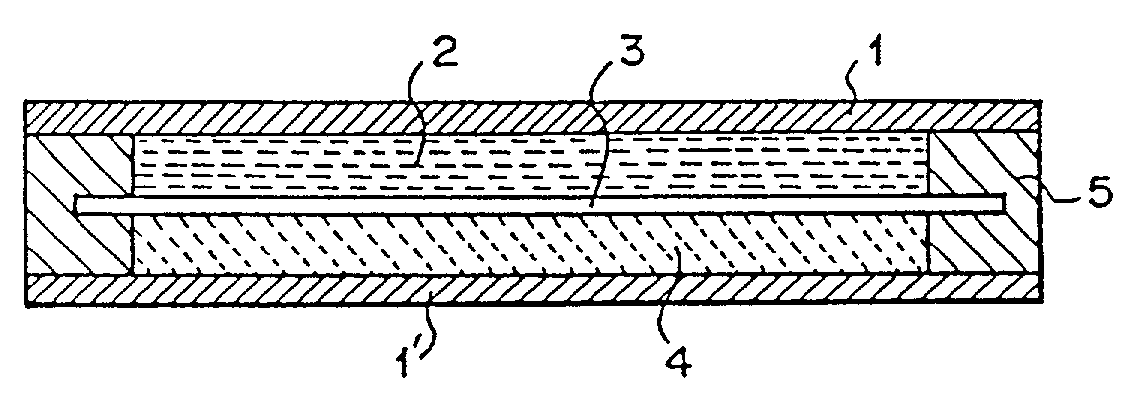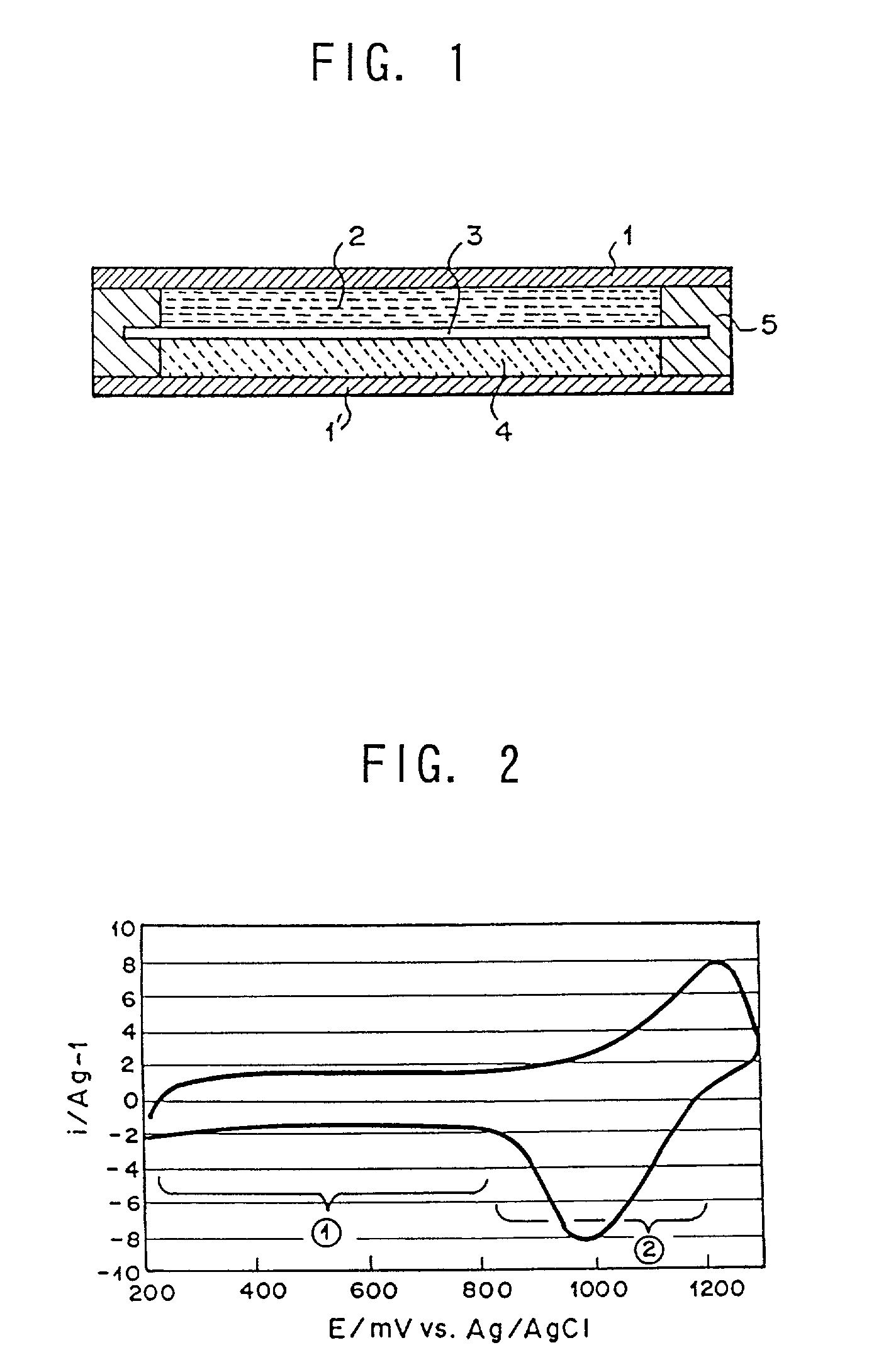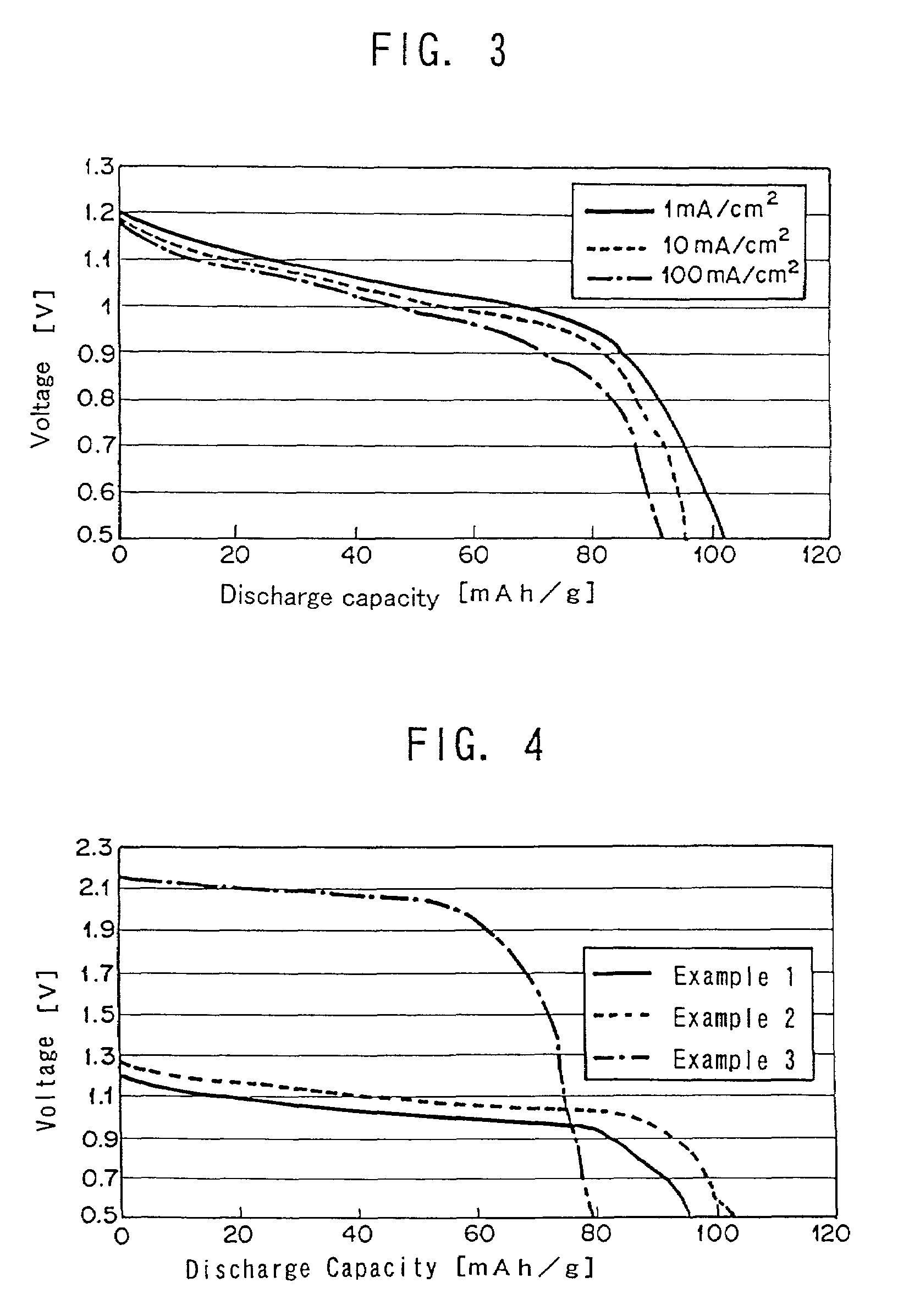Secondary battery and capacitor using indole polymeric compound
a polymer compound and secondary battery technology, applied in capacitor collector combinations, cell components, electrochemical generators, etc., can solve the problems of battery disadvantageous to large size of dopant anions, low mobility, etc., and achieve fast charging and discharging performance, high cyclic property, and high electromotive force
- Summary
- Abstract
- Description
- Claims
- Application Information
AI Technical Summary
Benefits of technology
Problems solved by technology
Method used
Image
Examples
example 1
[0036]A secondary battery was produced through the following procedures, using poly(6-nitroindole) represented by the following structural formula (2) as the anode material 2; polyphenylquinoxaline represented by the following structural formula (3) as the cathode material 4; and 40% sulfuric acid (5.3 mol / l) as the electrolytic solution.
[0037]
[0038]Poly(6-nitroindole) was mixed with crystalline carbon as the conductive auxiliary at a weight ratio of 75:25, followed by addition of dimethylformamide to solve poly (6-nitroindole), and drying at 120° C. Then, the mixture was pulverized, followed by addition of the electrolytic solution of 40% sulfuric acid (5.3 mol / l) to produce an electrode paste. This paste was coated over a collector 1 with a 500 μm thick gasket 5 to obtain an electrode of the anode material 2.
[0039]As for production of an electrode of the cathode material 4, polyphenylquinoxaline was mixed with Ketjenblack as the conductive auxiliary at a weight ratio of 75:25, fol...
example 2
[0050]A secondary battery was produced, using poly(5-cyanoindole) represented by the following structural formula 2′ as the anode material; polyphenylquinoxaline as the cathode material; and an aqueous solution of 40% sulfuric acid as the electrolytic solution, through the same procedures as those of Example 1.
[0051]
[0052]Poly(5-cyanoindole), used for the anode material was in a state that sulfuric acid ions were doped into it in the electrolytic solution, and the reaction accompanied with absorption and desorption of protons, corresponding to the reaction formula (2), proceeded about 1000–1300 mV vs. Ag / AgCl.
Accordingly, for the secondary battery, constant current charge and discharge tests were performed at 1–100 mA / cm2 with an electromotive force of 1.3 V.
[0053]The results from the secondary battery are shown in Table 1 and the discharge curve is shown in FIG. 4. Discharge curves at 10 mA / cm2 of Examples 1 and 3 are also shown in FIG. 4.
[0054]The discharge capacity achieved 85–77...
example 3
[0057]A secondary battery was produced, using poly(6-nitroindole) as the anode material; polyphenylquinoxaline as the cathode material; and propylene carbonate (hereinafter referred to as PC) containing 1 mol / l of tetraethylammonium tetrafluoroborate and 0.1 ml / l of trifluoroacetic acid as the electrolytic solution. The PC solution was substituted for the aqueous solution of 40% sulfuric acid of Example 1 to produce the secondary battery through the same procedures as those of Example 1.
[0058]Poly(6-nitroindole), used for the anode material, was in a state that tetrafluoroboric acid ions were doped into it in the electrolytic solution, and the redox reaction accompanied with absorption and desorption of protons, corresponding to the reaction formula (2), proceeded at about 800 to 1200 mV vs. Ag / AgCl. As for polyphenylquinoxaline of the cathode material, the redox reaction proceeded at about −1100 to −900 mV vs. Ag / AgCl. Accordingly, for the secondary battery, constant current charge...
PUM
| Property | Measurement | Unit |
|---|---|---|
| Fraction | aaaaa | aaaaa |
| Percent by mass | aaaaa | aaaaa |
| Substance count | aaaaa | aaaaa |
Abstract
Description
Claims
Application Information
 Login to View More
Login to View More - R&D
- Intellectual Property
- Life Sciences
- Materials
- Tech Scout
- Unparalleled Data Quality
- Higher Quality Content
- 60% Fewer Hallucinations
Browse by: Latest US Patents, China's latest patents, Technical Efficacy Thesaurus, Application Domain, Technology Topic, Popular Technical Reports.
© 2025 PatSnap. All rights reserved.Legal|Privacy policy|Modern Slavery Act Transparency Statement|Sitemap|About US| Contact US: help@patsnap.com



